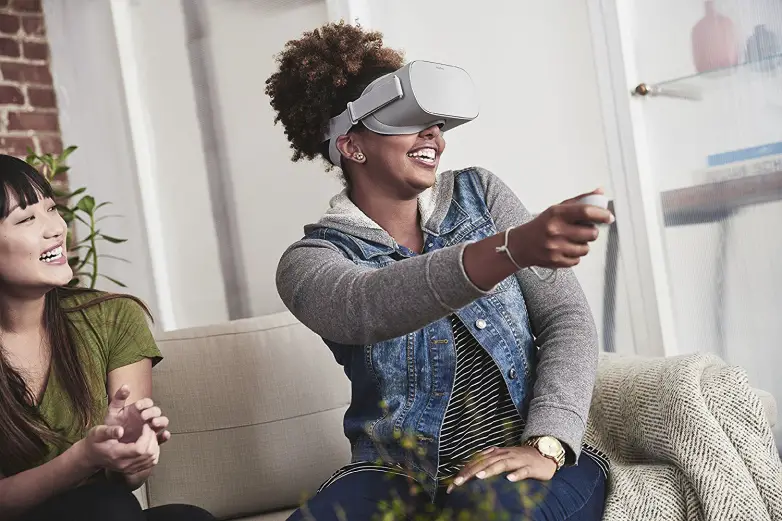Oculus, the Facebook-owned virtual reality company, has firmly established itself as a leading maker of quality virtual reality equipment. The company is known for its incredible virtual reality headsets that allow users to immerse themselves in almost every environment and situation possible without leaving home.
The first two headsets that Oculus produced were the Samsung-partnered Gear VR and the Oculus Rift. The Gear VR is specifically designed to work through Samsung smartphones, while the Rift requires a computer with specific software. Both headsets offer a large variety of games and experiences for users to choose from.
In May, Oculus introduced its third virtual reality headset: the Oculus Go, which is an entity of its own — literally. What sets the newest VR headset apart from its predecessors is its ability to function without an outside operating system, making it one of the few quality stand-alone headsets available. The freedom from cords and battery drainage make stand-alone headsets the most convenient virtual reality experience possible, and the Oculus Go is one of the best available for the price.
Plus, because it doesn’t require a specific phone or computer connection, it can be used regardless of what phone or computer you own, making it a great choice for everyone. You have to download the Oculus Go app for the first use, but it is now available for both iPhone and Androids. After the initial setup, you can use the headset at your leisure without the phone connection.
Of course, Oculus is not the first company to create a stand-alone headset. Others have been on the market for some time, including the Lenovo Mirage Solo and the Vive Focus. Each headset offers its own set of benefits and experiences that set it apart from the others, and price is often a factor in quality.
Oculus, however, aims to take its virtual reality experiences one step further than the other headsets. Although the company’s successes have been primarily aimed at the realm of 3D, Oculus is taking its expertise back to the well-established territory of 2D video.
On June 25, Oculus announced the launch of a new experience exclusively for the Oculus Go headset: Oculus TV. This new app allows users to treat the headset as a television hub for many favorite channels, all in a personal theater-style setting.
Oculus has teamed up with several streaming services in the past to add video experiences to their previous devices. These companies, such as Netflix, Hulu and Showtime, will all be available on the new Oculus Go. Oculus TV also boasts options like Red Bull TV, Facebook Watch, Newsy, MLB Live and Neverthink.
This is a pretty good selection for starters, and Oculus has announced an upcoming partnership with ESPN, as well. The board members at Oculus hope to entice a variety of additional channels and streaming services to partner with them in the coming months to boost the popularity and convenience of Oculus TV.
https://twitter.com/kylemhudson/status/1014332276749062145
As it stands now, a large number of people already use their virtual reality headsets to view videos on social media, YouTube and a variety of streaming services. Oculus TV is simply the first to bring all of these experiences into one place.
But why use Oculus TV over your traditional TV set? I’m glad you asked! The Oculus Go headset and TV app offer a variety of benefits and conveniences that give it an upper hand to your current TV.
The first major and rather obvious benefit is the price. At $199 for a 32 GB headset and $249 for 64 GB, the Oculus Go is far more affordable than most decent televisions or even large computer monitors. The fact that it doubles as a gaming system just adds to the sweetness of the deal.
So with the free Oculus TV app, you can enjoy much of your favorite TV content without the cost of an actual TV.
It’s obviously not a replacement for cable, but with the Wi-Fi connection, you’ll have a plethora of options for videos, movies and television shows.
The price ties in to benefit No. 2: the size. Although the Oculus Go headset itself is only a few inches wide and weighs about a pound, the screen within the Oculus TV app simulates a 180-inch television screen. If you want something even close to that size for your actual home theater, be ready to shell out several thousand dollars and clear some wall space.
The Oculus Go also offers the convenience of mobile entertainment. Because it doesn’t require any outside software, the headset can function wherever you are. If you want to stream video via Oculus TV, you will need an internet connection, but it still allows you to move your personal theater to your bedroom or favorite couch. You can even go to your favorite coffee shop if you don’t mind the stares.
Additionally, you can download movies and videos onto the Oculus Go for later viewing. Many users have already applauded the convenience of the headset for long plane flights or car trips. And if you happen to have a mobile hotspot, there are almost no limitations on when you can stream video content.
https://twitter.com/Ally_Beal_/status/1013467981400207361
The Oculus TV experience also provides the convenience of privacy that a traditional television lacks. In fact, the creators specifically designed the experience to be an escape tool, so the whole thing is as immersive and private as possible.
Because the headset only streams content to the wearer, people around the user will not be disturbed by light or frightening images like they could be by a TV. So you can watch your videos and movies without bothering your family while they sleep or scaring your younger sibling with a horror movie.
The headset also has a headphone jack in case you don’t want to use the built-in speakers. That way, you can keep the noise to a minimum without missing a single highlight of your favorite sports team or TV show. Moreover, excellent earbuds by Headphonesaholic can help you as well.
So what’s the actual Oculus TV experience like? Another great question!
The actual viewing experience is an intriguing mix of a virtual reality living room and the 2D video screen, but Oculus assures that the entire room is designed for comfortable and distraction-free viewing.
When you open the app, you’ll find yourself within a modern and sleek home-theater area with a scenic view, roomy couches and the 180-inch screen front and center.
The screen displays up to two rows of possible applications at a time to launch from within Oculus TV. If you have subscriptions to programs like Netflix, Hulu and Showtime, those will appear alongside the pre-programmed apps like Facebook Watch and Newsy.
You can select the app of your choice using the touch-surface controller included with the Oculus Go. Once that app launches, you can browse for channels, videos and movies to stream on the giant screen.
Some people have questioned the quality of the 180-inch screen equivalent, and it’s a valid concern. Obviously, it’s not going to be a 4K viewing experience. However, Oculus has worked hard to ensure that the screen is as vivid as possible with some enhancements made to the newest headset.
The Oculus Go offers optimized 3D graphics and the option to bump its performance up to 72Hz over the standard 60Hz, providing brighter colors and clearer graphics.
Just spent 40 min wearing my first #vr headset. The #OculusGo is comfortable. Not being a gamer this is quite mind blowing for me! pic.twitter.com/dxhgVfI3Gc
— 🇨🇦 #letsmeetinvr (@donnamct) June 8, 2018
The headset also contains Fresnel lenses, which Oculus customized to reduce the glare factor of previous headsets. They also increase the user’s field of vision to mimic the capabilities of the Oculus Rift over those of the original Gear VR.
If these features aren’t enough, the Oculus Go offers several accessories that can improve the overall performance and picture of the headset for individual users.
If you’ve ever used a virtual reality headset, you might have noticed some fuzziness in the picture due to a bad fit or simply your personal eyesight limitations. The fuzziness obviously detracts from the experience and can even cause headaches.
Oculus Go aims to fix all of those problems with fitted interfaces and prescription lenses. The fitted interfaces allow users with “low nose bridges and high or wide cheekbones” to use the headset more comfortably. A better fit means better viewing and less light seeping in through the bottom. The prescription lenses can be custom ordered and popped right in to help users with vision impairments enjoy the best viewing experience possible.
With all of these improvements and accessories, Oculus plans to make Oculus TV the most convenient and immersive viewing experience possible for the price. Plus, with the ability to play games on the same headset, the Oculus Go is a perfect one-stop choice for those who want everything in the same place. Get yours at Oculus and see what the future of entertainment looks like.

















